Whilst the Canary and the Zebra Finch remain the most popular types of pet finch, there are dozens of finch species available as pets. The following is a list of the most common. All are members either of the Estrildid or Waxbill family, close relatives of the Zebra Finch.
Java Sparrow

Java Sparrow - first pet bird to conquer Asia
The Java Finch, as the name suggests, is native to the island of Java, Indonesia. They can be found on other Indonesian Islands too, however. The bird's latin tag, oryzivora, means “rice-eater”, they have made a bad name for themselves by feeding on rice fields together in large flocks. This feat has also earned them the alternative names of “Java rice sparrow” and “Java rice finch”. Numbers in the wild have been massively reduced, irate rice farmers are somewhat to blame here, and the species is officially endangered in its natural habitat.
Outside of Indonesia, introduced populations have managed to thrive in Hawaii. There are also millions of birds in captivity. This bird has never managed to shake its rice eating reputation, and still to this day it is illegal to own a Java finch in California, just in case feral populations descend on to the local rice fields. It is also illegal to import specimens into the USA.
The Java Sparrow is the true giant of the Finch scene, their large beak only adding to the general look of bulkiness. They measure around 5.5-6.5 inches. As of late this species has become more and more of a popular cage bird, and they favor larger seeds such as oats, white millet and sprouting rice, as opposed to the much smaller seeds preferred by other finch species. They will happily nest in trees and buildings in the wild, and don’t seem to have a problem with breeding and nesting in captivity.
It is this species, rather than the Zebra Finch, that is the true grandfather of all pet finches in Asia. They were first kept by the Ming Dynasty in China during the 14th century, and became very popular in Japan during the 17th century.
The Gouldian Finch
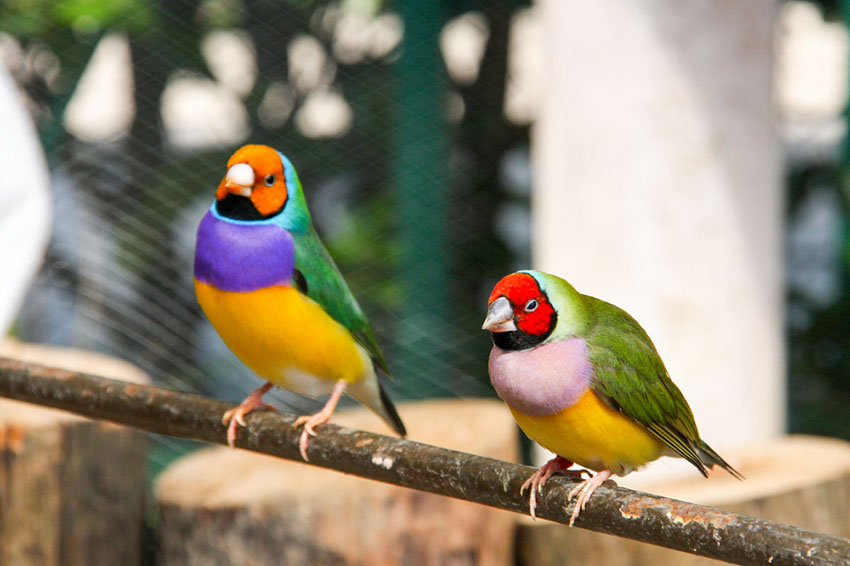
Gouldian Finch - endangered in the wild, but common in captivity
The first thing you notice on this species (Erythrura gouldiae) is its bright, multi colored plumage. This has earned it the nickname “Rainbow Finch”. They get their name from the British ornithologist John Gould, who was the first to describe the bird to western science back in 1844. The name he chose for it was “Lady Gouldian Finch”, after his wife Elizabeth.
This bird is actually endangered in its native habitat of Northern Australia but there are several hundred thousand living and breeding in captivity. The bulk exportations of this bird during the late 19th and early 20th centuries did nothing but slowly deplete the wild numbers of this finch. In 1960, Australian authorities banned the exportation of all native animals, including the Gouldian Finch.
The Gouldian is another larger finch, coming in at 5.5 inches in length. In the wild they nest in trees near a water source. The birds will feed in flocks during the dry-season, often merging with other, similar sized seed-eating species. In their heyday, flocks of this bird could reach up to 2000 individuals large, but during the 20th century these numbers dropped alarmingly.
This bird is interesting in that they come in different “phases” or head colors. The most common of these phases are the black-headed finches, which account for about 75% of the wild population, the other 25% are red-headed. There is also a very rare golden-headed variation, but their numbers are so low (around 0.5% of the wild population) that they don’t affect these approximate percentages. Captive birds have over time developed several different plumage colors, making them the most striking and colorful of all the finches.
The Gouldian has a very odd genetic juggling trick. Where if black headed birds mate with red headed birds, almost all of the resulting female chicks die. This is down to a genetic incompatibility and suggests that the bird is in the process of splitting into two different species altogether, rather than just subspecies. This being said, in situations like this, the hen is able to produce a much higher ratio of male birds (around 4 males to every 1 female), in turn ensuring the survival of the majority of her brood. The actual reason for this is not entirely understood, but the phenomenon has been confirmed by scientific research. In the study, red-headed cock birds’ heads were colored black in order to fool the red-headed hens. The hens, thinking that they were mating with a black-headed bird, produced more male chicks, seemingly proving the fact that hens have at least some control over this phenomenon.
Double-Barred Finch
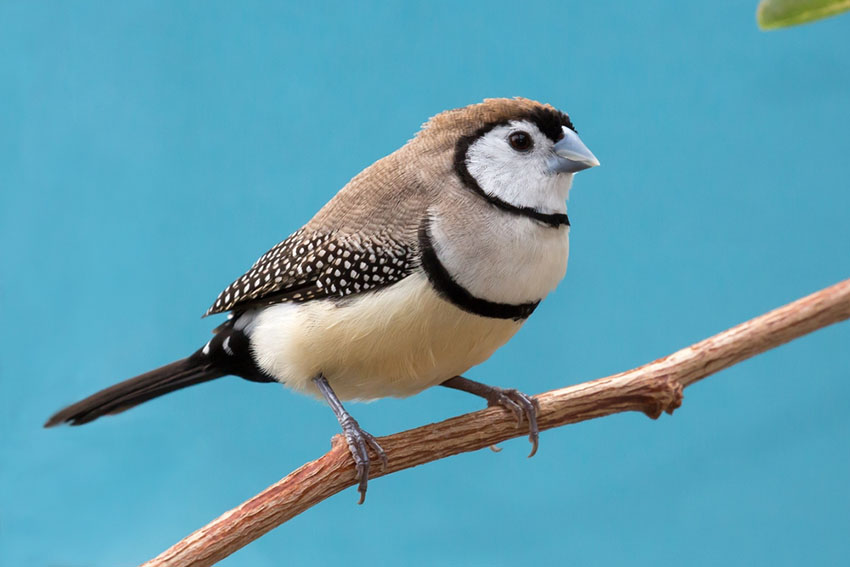
The Double-barred Finch - also known as Owl, Clown or Bicheno's Finch
This is a popular species and goes by several other names, the Owl finch, Clown Finch and Bicheno’s finch. The latter of the three is a nod towards the mid-19th century bird enthusiast colonial secretary of Van Diemen's Land (modern day Tasmania, James Ebenezer Bicheno. The bird’s latin name, Taeniopygia bichenovii, reflects his name too. The bird is smaller, measuring around 4 inches.
This species is native to eastern Australia, though the wild population is divided into two subspecies - Taeniopygia bichenovii bichenovii and Taeniopygia bichenovii annulosa. These subspecies are also referred to as the White-rumped and Black-Rumped double barred finch, giving hint as to the main differences between the two. The birds are seed-eater and choose to build their nests close to the ground, usually in thick grasses or shrubs.
The bird is a close relative to the Zebra Finch, and many bird keeps opt to keep the tow species in the same cage.
The Bengalese Finch
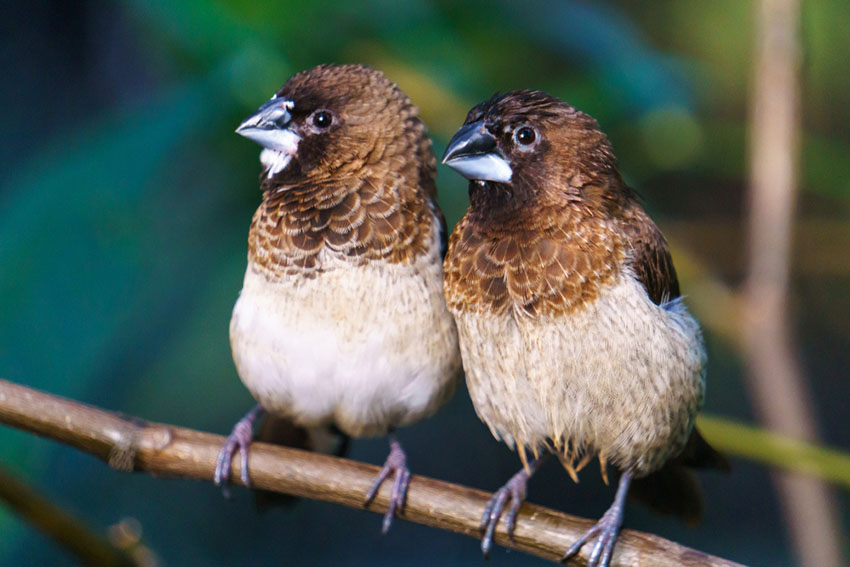
The Bengalese Finch, also known as the Society Finch, only exists in captivity
This is a rather odd species as it doesn’t actually exist in the wild. The bird measures in at 4 inches long. Whilst for a long time it has been believed that this species is descended from the White-Rumped Munia (Lonchura striata), this has only recently been proved with modern DNA analysis. Bengalese finches are therefore known as Lonchura striata domestica and usually go by the name “Society Finch” in North America.
Seeing as this bird was bred specifically for captivity, it comes as no surprise that they are indeed well adapted to cage life. The only thing that keeps it from being the go-to pet bird is its rather dull brown-based plumage.
Society Finches are sociable animals, roosting and even nesting together. It is in fact these very traits that have earned it the “society” tag. This bird also mixes very well with other species and makes for a good addition to any aviary. Breeders have managed to create several different varieties over the years, though they all retain the same brown-white base colors.
Star Finch
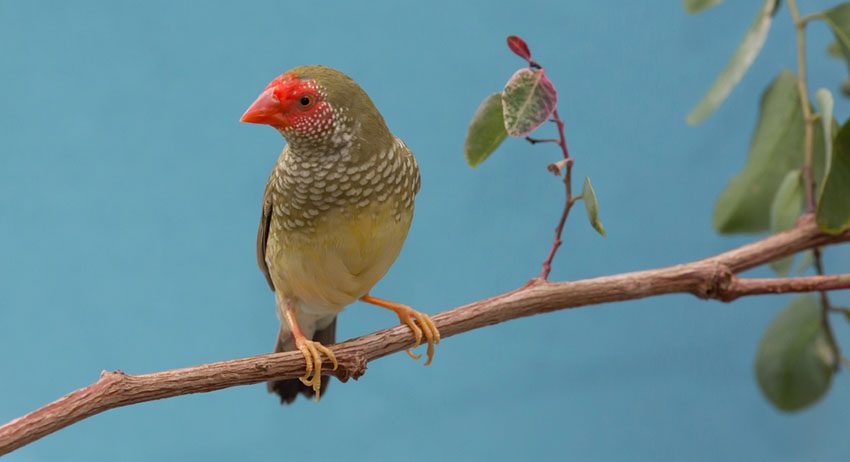
Star Finch - shining bright, in a timid kind of way
The Star Finch measures in at around 4-4.7 inches in length and is native to Australia. The species has seen a rise in popularity over the last 50 years and there are now several well established color mutations, such as the yellow form where the usually red face is a dark yellow. There are also cinnamon and fawn variations. The Star Finch is a bit more timid than other birds and can only be mixed with less aggressive species.
Plum-Headed Finch
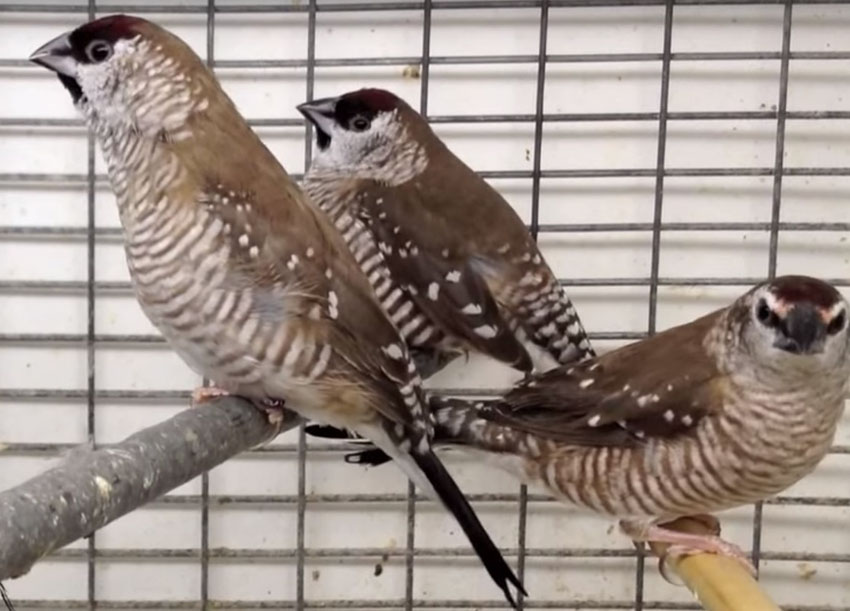
Plum-headed Finch - a good mixer
The Plum-Headed Finch is a close relative of the aforementioned Star Finch and is, again, a native of Australia. They don’t stand out quite as much as their Star Finch cousins and as a result are a less common pet. They are, however, less timid than their Star Finch relatives and make for a good addition to any mixed aviary.
Strawberry Finch
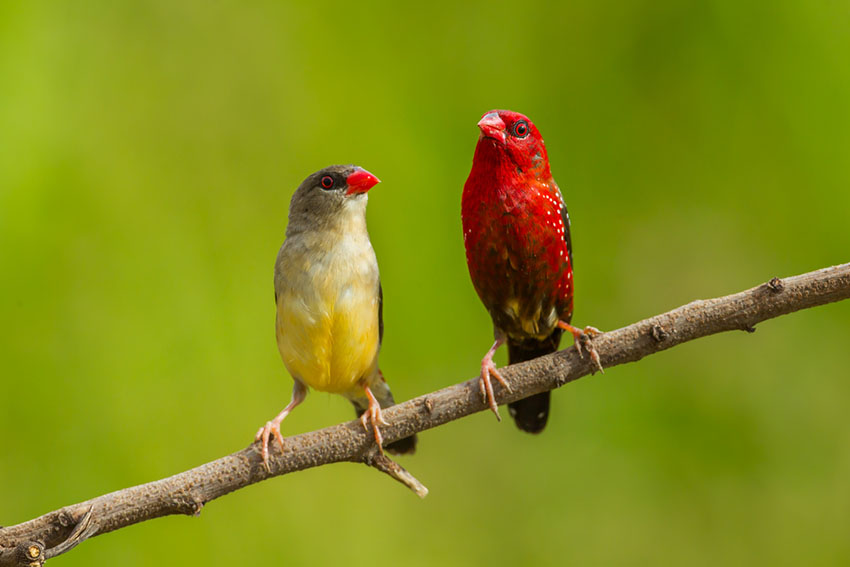
Strawberry finch - the male and female look like separate species
The Strawberry Finch, also commonly known as the Red Avadta or Red Munia (
Diamond Firetail
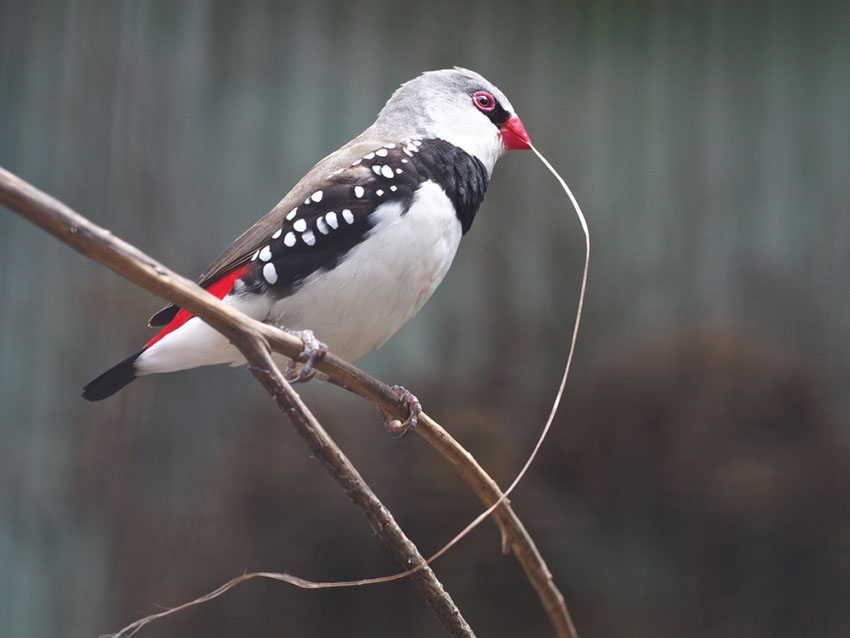
Diamond firetail - confusing by name, cantankerous by nature
The Diamond firetail (Emblema guttata) is yet another Australian Finch. They have a very striking plumage with flashes of red and splodges covering the breast and flanks. There are several variations on domestic Firetails, such as the yellow diamond, in which the red plumage is instead orange. The bird's beauty makes it an impressive addition to any aviary, though they can be cantankerous at times, especially during the mating season. This species is sometimes referred to simply as the Firetail Finch, though this can be confusing as there are other species of Finch also referred to in this way, such as the Beautiful Firetail Finch, the Red-browed Firetail and the Painted Firetail Finch, all of which are sometimes kept as cagebirds.
Parrotfinches
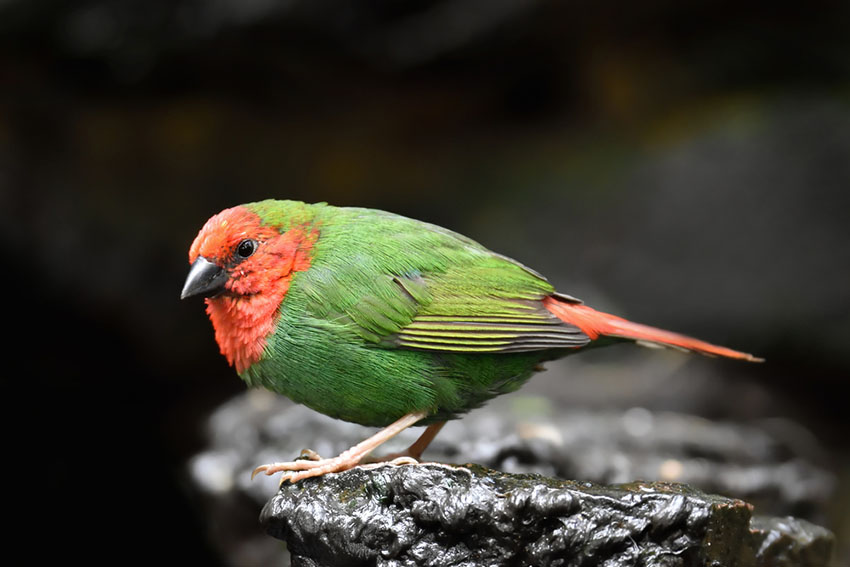
Red-throated Parrotfinch - one of several types kept by finch fanciers
The Red-headed or Short-tailed parrotfinch (Erythrura cyaneovirens), the Red-throated parrot finch (Erythrura psittacae) and the Blue-faced parrotfinch (Erythrura trichroa) are all kept by aviculturists. They range from 4-5 inches in length. They are native to the Samoan and neighbouring islands off the eastern coast of Australia. They have very striking appearances, with bright, vibrant plumage all over their bodies. There is also a yellow headed variety of the Red-headed bird, this variation is called the Sea-green. In general, these are easy to keep birds, though they aren’t quite as sociable as other finches but they still function well in an aviary, as long as there's plenty of space for them.
Cut-Throat Finch
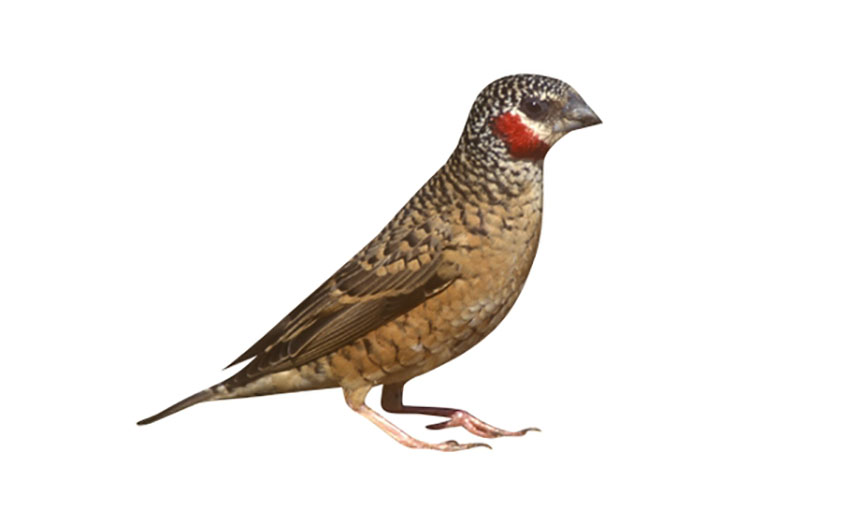
Cut-throat finch - with an aggressive temperament to match its name
The Cut-throat finch (Amadina fasciata) also goes by the names of Bearded finch, Ribbon Finch, Cut-Throat mannikin, Flame-Throated amadina, Flame-Throated Finch and several other names, all nodding towards the strip of red plumage found on their neck area. They are native to Africa, though there is also a thriving introduced population in Portugal. They tend to be more aggressive than your average finch and have a reputation of wrecking other bird’s nests in the aviary. This aggression won’t be as apparent if they are kept with birds of the same species or similarly robust birds. They can reach lengths of up to 5.2 inches, making them one of the larger finches.
Lavender Waxbill
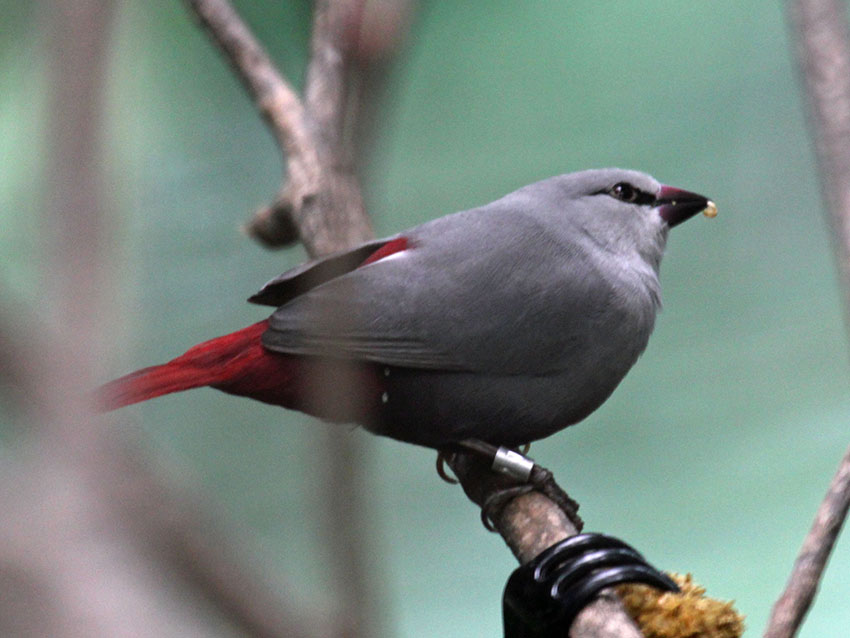
Lavender waxbill - pricey birds
The Lavender waxbill (Estrilda caerulescens) is a relatively small bird, only measuring 4 inches in length. Despite their small size they will need a fair bit of room as they tend to get stressed and aggressive in enclosed spaces. In the wild they inhabit tropical and subtropical African countries, and there is a well established introduced population living in Hawaii. They are a prized cage bird and come with a high price tag. They are close relatives of several other waxbill species that can be found on the pet market too.
Chestnut Munia
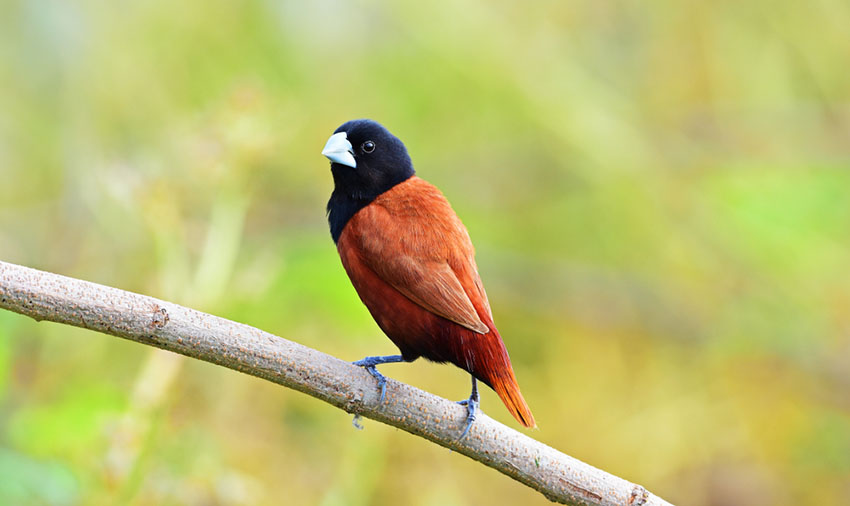
Chestnut Munia - seeks safety in numbers
The Chestnut Munia (Lonchura atricapilla) also goes by the name Black-headed Mannikin/Munia/Nun. This is an Estrildid finch that has a wide range, spreading through China, North-East India, Indonesia, Malaysia, Thailand, Vietnam, Taiwan, Singapore and the Philippines. The sheer size of their range has led to there being many subspecies, 10 to be exact. Hawaii also has a population of feral Chestnut Munias. They are a very sociable bird, flocking wherever there are grasslands and water supplies. They are one of the many finch species that find cultivated land simply irresistible. They measure in at around 4.3-5 inches in length.
Scaly-breasted Munia
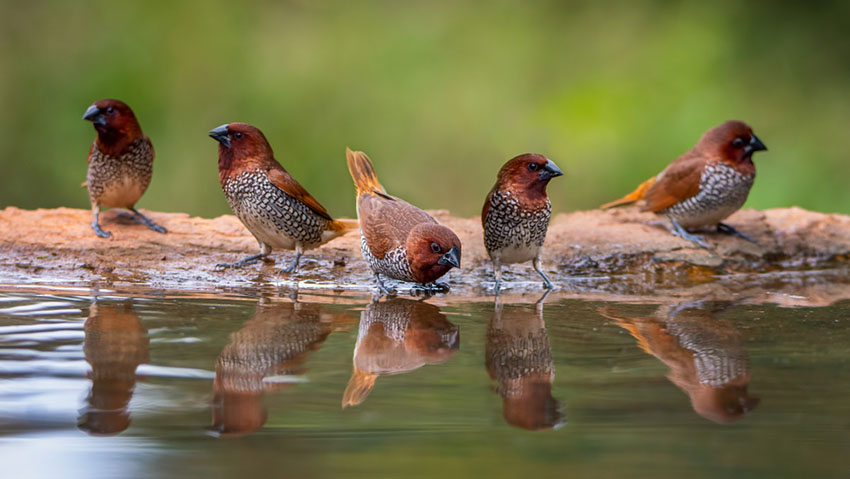
Scaly-breasted munia or Spice finch - easy on the ear
These birds are also often called the Spice-Finch, Spotted Munia or Nutmeg Finch. They are around 4.5 inches in length. They have a wide range, stretching across much of tropical Asia. They are a popular pet throughout the world. This is a flock bird, usually they live together in groups of around 100 or so. There are feral populations in Australia, the USA and Puerto Rico. They are relatively easy to breed and this has definitely helped with their popularity. They are also a quiet bird and make for a good pet if you don’t want a noisy bird. Their name refers to the scaly-like plumage along their breast.


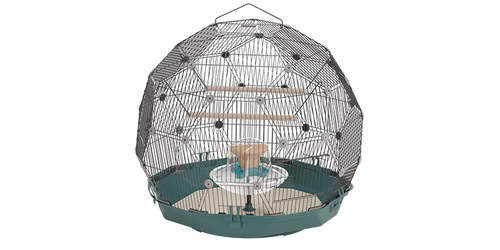
Comments
Sue, 16 February 2022
My australian zebra finch seems to have a sore foot, it's been going on for months and I'm worried. Vets don't treat these little guys. What should I do?
Chau, 22 November 2019
plum headed finch
Kelly, 5 April 2019
Take to a veterinary hospital for your pet
Sergio, 23 January 2019
I have a finch and he has a broken leg what should i do